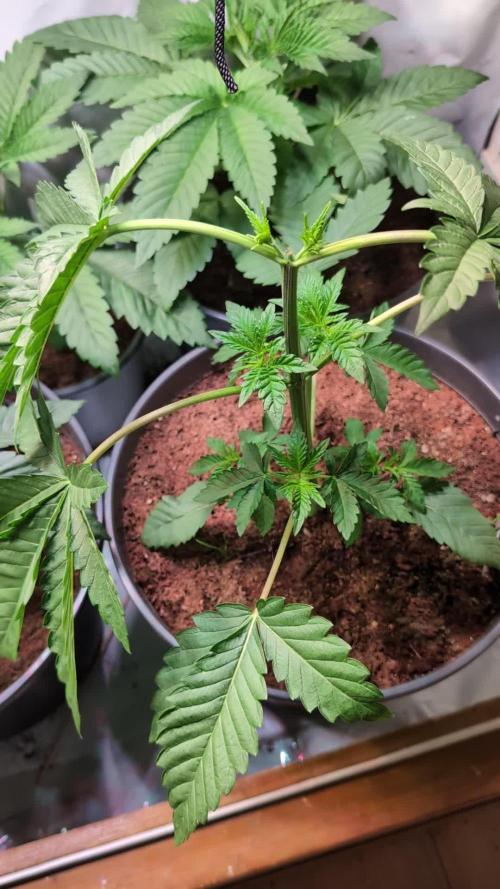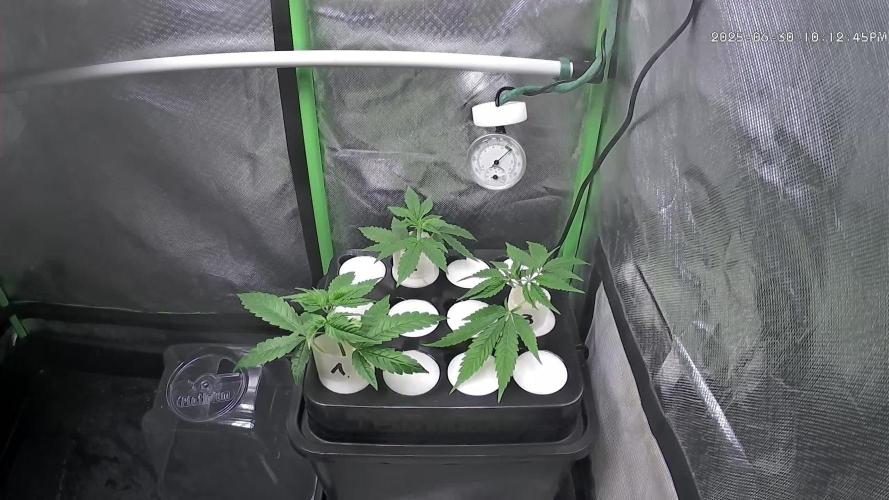The Grow Awards 2026 🏆 



































Likes
Comments
Share


@High_And_Hydro
Follow
An Tag 43 wurde mal wieder entlaubt. Sie werden dieses mal wieder riesig, das ist mal klar. Sie riechen auch schon ein wenig, ich freu mich auf jeden Fall. 👽👍
Tag 45: Ich hab sie dieses Mal wieder ins Netz gesteckt, da die Jungle Lava dafür einfach sehr gut gewachsen ist. Es sieht ja immer ein wenig krass aus, wenn man fertig ist 😅
Tag 48: Sie haben die Entlaubung gut verkraftet und strechen weiter.
Likes
1
Share


@GoodTimesOrganics
Follow
Welcome Back!💚
Trotz den gleichen Bedingungen der Verschiedenen Pflanzen fällt mir jetzt besonders auf welchen enormen Stretch die Pink Sunset hinlegte.
Sie hat in diesem Run die längsten Interniodenabstände und die Seitentriebe kommen noch nicht so richtig in die Gänge.
Hier war die Zeit des toppings fast schon einen ticken zu spät, wobei die Pflanze dies mit der Zeit sicherlich wieder ausgleichen wird.
Die Umgebungsgegebenheiten sind weiterhin optimal:
—————
🌞 Temp: 24°C bis 26°C
🌚 Temp: 18°C bis 19°C
💨 RH: 68%
VPD: 0,7 kPa👍
—————
Grüne Grüße 🥦
Likes
41
Share


@Ganjagrandaddy
Follow
DAY 56 f: well here we are folks. The final week for these girls to impress and sparkle with the build up of their trichromes.
The Six Shooter are the closest to the harvest time and i think i will be taking them out 1st. They have some beautiful purples and dark reds on their leaves and buds and the smell is so damn potent too. Very fuel terped so far but really potent to inhale. Both have different sizes but identical buds to represent the strain really well. I think their bag appeal will be top drawer.
The Mexican airline are also close now and smell.so fruity fresh that it hits your throat with a sting. Lol not the biggest ladies for production but some beautiful looking buds on them.
The Strawberry pies are another level altogether....
#1 is so fresh and vibrant looking with most of her leaf left on stil. I think she may go another week before her sweet spot is here though. She has a lot of good sized mains around the plant and they look and smell line fresh chopped pineapple so far. #2 has had her main leaf taken out for the past 5 days to encourage as much light around the numerous beautiful buds she has produces. I did supercrop her main to keep her from hitting the light and have noticed how floppy she is becoming from the weight building in the bud tips. I love how she looks now with the edible looking buds everywhere. Some of the best buds I have had the pleasure of seeing in these autos. Roll on harvest time. The soil has performed brilliantly throughout the whole grow this run and with a no-till method being used in the trays , I expect it to get better each new run. The organic/vegan soil also means any edibles are as clean as can be from home growing. The lack of harshness from using nutes is very noticable in my grows now and drying really is just about the moisture removal and natural chemicals so curing is a lot shorter. Instill get the gassy , initial conversion when using jars but it is more about the potency of the hit than the harshness of residual chemicals. While there is a slight loss in yield from soil , the smoke quality certainly makes up for it. So there we have it growmies. A great final week ahead and some beautiful bud porn for you to enjoy in the pics. Have a brilliant start to your 2022 and the future. Be well.
Likes
5
Share


@Pureleelove
Follow
This was an amazing experience for my first grow. Was super unsure of what I was going to yield, but I think 27 grams is a realistic harvest and Im looking forward to see if I can get bit larger of a yield on the next run. I want to try main-lining, see for better energy distribution and more equal bud growth. Also investment into a proper reflector and possibly enclosed space.
Note- I trimmed my plant the night before harvest morning. I removed than fan leaves to start, and then proceeded to trim the plant. I pulled out a lot of the leaves with no frost by hand. The sugar leaves had so much crystal on it I thought I would leave the smaller ones on the bud. I gave it a light trim, and used all the trim to make Isopropyl Alcahol (99%) based extract. Got about 1 gram from the run. I also had a nice little ball of finger charas from the trimming.
I harvested it in the morning at about 04:30 am before the light cycle triggered at 7am. She hung and dried for about a week, where I then chopped her into buds. She cured for 2 weeks before i started smoking.
Ask anything you want to know! Or if I can be more clear on any areas of the grow!
One Love!
Likes
3
Share


@maxpain
Follow
Missed one week off uploads was real busy but this one coming along good ...smells real strong ..cant wait...the orgainic way......
Likes
2
Share


@el_cultivito
Follow
Set up net trellis.
Tried to set up a DIY CO2 generator but could'nt seal it right.
Likes
34
Share


@JonnyKush
Follow
Day 65
past nutrition problems I believe have slowed growth. unfortunately on a plant I think I have problems with the compaction of the soil which has caused too much irrigation. the plant does not eat and a little slower than the others. now after 4 days to dry i will give only datpo water which seems to burn for nutrients, i believe brought about by the fact that they are deposited in the soil. all in all they continue to grow and hope for the best! 💚🌱
Likes
2
Share


@Organic473
Follow
Finally decided to sow these seeds from the diary "Sensi Seeds Durban V1" crossed with Sensi Skunk Regular Male. I will be vegging these girls hopefully until the dry seasons starts here late January 2025 Jah will.
Likes
8
Share


@Mr_nugs_lover_David
Follow
Fantastic strain, very happy with the 3 phenos I'm growing, this ak420 has a very sweet and floral aroma, I'm very happy about her, cannot wait to smoke those nuggets to taste the flavor, I know it's gonna be very sweet! 🤤💚❤️💛🔝
Likes
29
Share


@Hashdestroia
Follow
Overall i'm really happy with this strain. First i thought i wouldn't get a high yield but i'm pretty happy with it i got 250grams of top trimmed buds 2g of hashoil 2g of bubblehash and another 80grams of dry plant material for making bubblehash. Super potent strain with an amazing flavour, definitely nit the last time growing this strain.
Processing
Likes
9
Share


@Smokwiri
Follow
Welcome to week 25 of my bubba slush diary
Genetics by Greenhouse seed co.
Welcome to my 2nd diary within diary.
The first diary is already harvested.
The second one has been in veg for about 20 weeks, while it was in veg, i trained it with lst and hst, now we are a in flowering for a couple of weeks.
Third diary will come within this diary too, i took a monstercrop clone, it's revegging now, curious of the outcome, since this strain already has tight internodes on the branches.
Buds packing, smell is dank
This week again some green sensation
And ghe (terra aquatica) pro bloom.
Also added some new pictures of the revegging monstercrop clone.
No weird deformation in leaves, so.e yellowing leaves showing, that means that another bunch of roots have been settled.
Likes
12
Share


@cookingwithninja
Follow
day 42 images are in last week, I can not count XD. bridal is stacking a lot of weight and is constantly shifting/leaning every morning, good things. I would chop any day but I will wait it out. water, tiny bit of humic and folvic to reduce chloromine, chlorine- air stones
day 45 took a few nugs off on day 42, dried for 3 days. Tried bridal and blackberry. As a heavy recreational, thc is up there! bridal felt like having a blindfold over your eyes somewhat sativa uplift but heavy weight feelings. Very good. Lasted as good as 30%'s. Dr. Thunder was also very nice, nug was smaller so mixed with blackberry to have a small j. Also feels very good indica. Both trials were chopped on week 6 day 1. Very pleased with the results. I was worried bridal was more sativa; which charasteristica I am not looking for. So I believe this is a very good heavy hitter run with 4 plants. I can chop any day, but I am waiting for pink paradise to finish seeds.
day45 took top nugs from bridal party, blackberry oreo bigstuff and dr. thunder. No touching pink paradise!!
day 46 can chop anytime just waiting on pink paradise seeds to finish, bridal party leaning more
day 47 bridal leaning hard from weight.
day 48 stacking, day 48 video
Likes
6
Share


@DrShotzUK
Follow
BANANA PURPLE PUNCH - 420 FAST BUDS
This plant started off stunted and looking all round unhealthy but I gave hear time lowered her nutrients and she’s come right back to life forming nice dense dark purple buds …
The smell is amazing she smells of berries and lemony woody gassy smell. Nothing like banana if you ask me!
Cannot wait to smoke this strain
DRSHOTZUK
Processing
Likes
11
Share


@Microsun
Follow
Flowering is going amazing, this candy cane is growing some very fast weight and caking up with Trichome’s. The sweet and slightly minty berry smell is growing in power day by day, and I’m very happy with how the size of the buds are developing since adding the increase of 2-8-4 and fish bone meal, just a little bit, not too much at all and she’s reacting great, knowing that the candy cane is a larger auto in size makes me a bit sad with the total size of this plant, but in its young age as my very first auto I believe I probably stunted it, but after all this and how she looks now Im more than happy with the growth, yield and quality of it, just speaking now as I do not obviously know how much I Will revive from it, I’m guessing about a ounce. No small bud sites other than maybe one on a lower branch that already has a main top cola on it. The main cola is massive and packing on a lot of size. I’ve switched the light to a hour less now as I am growing 2 photo indica L.A grape and with the season change I am having to fix my temp and humidity more for the photos, so changing to a 17-7 schedule has actually helped quite a lot and also has helped my other autos veg slightly better. But all in all I’m very exited!
Likes
23
Share


@Smokwiri
Follow
Flowering period has started
very very happy with the result of the LST too
the LST didn't cause any stress
size of plant is good
ec is at 1.35, i started adding molasses for the friendly bacteria
I added some pictures of the cat for the Artsy stoners competition featuring my B-class Toyger (designercat).
Likes
6
Share


@Ninjabuds
Follow
The permanent marker plants we'll they both took a little stress after reporting but they have bounced back. They both are back to having leaves praying. They are a little finicky still the one with the father leaves is not so bad but the thin leaves plant. At 1st it looked as I'f it wanted nutes from being so light green then when ingot nutes with the rest the plants it got a little crisp on the edges. It's still going strong no need to worry
This past week all the plants did great dealing with getting repotted and topped in the same week. I definitely took a Rick doing that seeing i only left each plant with 4 leaves. This past week was also a struggle to keep the vpd in a decent range. The Temps outside have been below 32 for a few days with Temps dipping down to almost 0 at night. With the space heater running it's pulling the humidity down. I think I have figured out the solution to that problem so I won't run into that next time it gets cold again. All the plants have really started to grow their new branches sense being topped. A few of the plants are a little smaller than I'd like but I'm gonna keep em alive for now.
Likes
8
Share


@MrAutogrow
Follow
She didn’t skip a beat since she was mainlined. Judging by how close her nodes grow, I will Either give her a traditional mainline or a flux style. Leaning towards traditional. So far, so good.
Likes
Comments
Share


@Lynx_361
Follow
29.06.2025
Took a clone from each of my Plants on day one of flower.
30.06.2025
Did some LST..



















